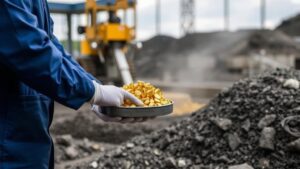Prospecting for Silver in Historical Smelting and Refining Locations
Introduction to Silver Prospecting
Prospecting for silver has long captured the interest of explorers, miners, and investors alike. Historically, silver has been valued not just as a precious metal but also for its essential role in various industries, including electronics, medicine, and photo production. This article will delve into the prospecting practices in historical smelting and refining locations, equipping readers with foundational knowledge and practical approaches for successful silver exploration.
The Historical Significance of Silver Mining
The significance of silver mining in human history cannot be understated. Silver has been mined for thousands of years, with traces of ancient extraction in regions such as Mexico and Peru. The 16th-century Spanish conquest of these areas marked the beginning of large-scale silver mining, particularly in places such as Potosí in Bolivia, which became synonymous with silver wealth.
In the United States, significant mining booms occurred throughout the 19th century, notably in Nevada’s Comstock Lode and in California’s Sierra Nevada. The impacts of these mining efforts shaped economies, influenced global silver markets, and even spurred migrations of hopeful prospectors seeking their fortune.
Identifying Historical Smelting and Refining Locations
A crucial step in prospecting for silver involves locating historical smelting and refining sites. e locations not only represent former mining operations but also serve as repositories for leftover ore and slag that contain residual silver. Understanding their characteristics is essential.
Significant Historical Smelting Sites
- The Comstock Lode, Nevada
- Potosí, Bolivia
- Silverton, Colorado
- Leadville, Colorado
Each of these places carries historical weight and is well documented in mining history. They have been focal points of silver production, with numerous maps and historical records indicating their locations. By exploring these areas, prospective silver miners can potentially uncover valuable deposits.
Techniques for Prospecting Silver
Effective prospecting in historical smelting and refining locations requires a robust methodology. Here are some key techniques:
1. Research and Historical Analysis
Before venturing into any site, conduct thorough research. Use resources such as old mining records, geological surveys, and historical texts to learn about past operations. Maps can provide insight into where smelting was concentrated, highlighting possible locations for silver remnants.
2. Soil Sampling and Analysis
Once a promising site is identified, soil sampling is a crucial next step. Collect soil samples from different depths and areas within the site. These samples can be analyzed for metallic content, particularly silver. Advances in technology have made it easier to conduct such analyses, providing precise readings on metal concentrations in the soil.
3. Use of Metal Detectors
Metal detectors are invaluable tools for silver prospecting in historical areas. By scanning the surface of former smelting grounds or refining sites, prospectors can detect buried artifacts and remnants of silver. Choosing a metal detector with a high sensitivity to silver can lead to successful finds.
Environmental Considerations and Ethics
When prospecting in historical locations, its crucial to consider the environmental impact of such activities. Many older sites may have residual pollutants from previous mining activities. It is essential to adhere to legal regulations and obtain necessary permits to avoid damaging the ecosystem.
- Always follow local environmental regulations.
- Rehabilitate any disturbed land.
Real-World Applications and Case Studies
Several modern prospectors have leveraged historical knowledge to achieve success in silver mining. For example, the revival of interest in the Comstock Lode in recent years has led to the exploration of old mines using modern techniques, resulting in the discovery of new silver deposits. This blend of historical reverence and contemporary technology exemplifies the potential for rediscovery in these infamous locations.
Conclusion
Prospecting for silver in historical smelting and refining locations presents a unique opportunity for both seasoned miners and newcomers. By employing rigorous research, utilizing advanced tools, and maintaining an ethical approach to the environment, prospectors can unlock the untold wealth that these historic sites may still offer. As exploration continues, the tradition of silver mining as a dynamic and potentially lucrative endeavor remains vibrant.
Actionable Takeaways
- Conduct thorough historical research before prospecting.
- Use soil analysis to guide your efforts.
- Invest in high-quality metal detection equipment.
- Always prioritize environmental responsibilities.


